When writing about the 6mm-284 in my column for Handloader No. 336 (February, 2022) I mentioned purchasing my first rifle chambered for that cartridge from a retired fireman who was an avid benchrest competitor, varmint shooter and deer hunter. His name was Herb Campbell and when he decided to sell his entire collection, I bought several others including a Winchester Model 70 in 220 Swift, two early Sako rifles in 218 Bee, 222 Remington Magnum and a 1940s vintage Mauser in 220 Rocket. Also included in the deal was a heavy-barrel benchrest rifle in 220 Arrow built on a 1917 Enfield action by Bob Wallack who worked for Marlin and authored
Modern Accuracy, the first comprehensive book published on modern benchrest competition. The rifle in 220 Rocket I purchased was built by Roy Weatherby.
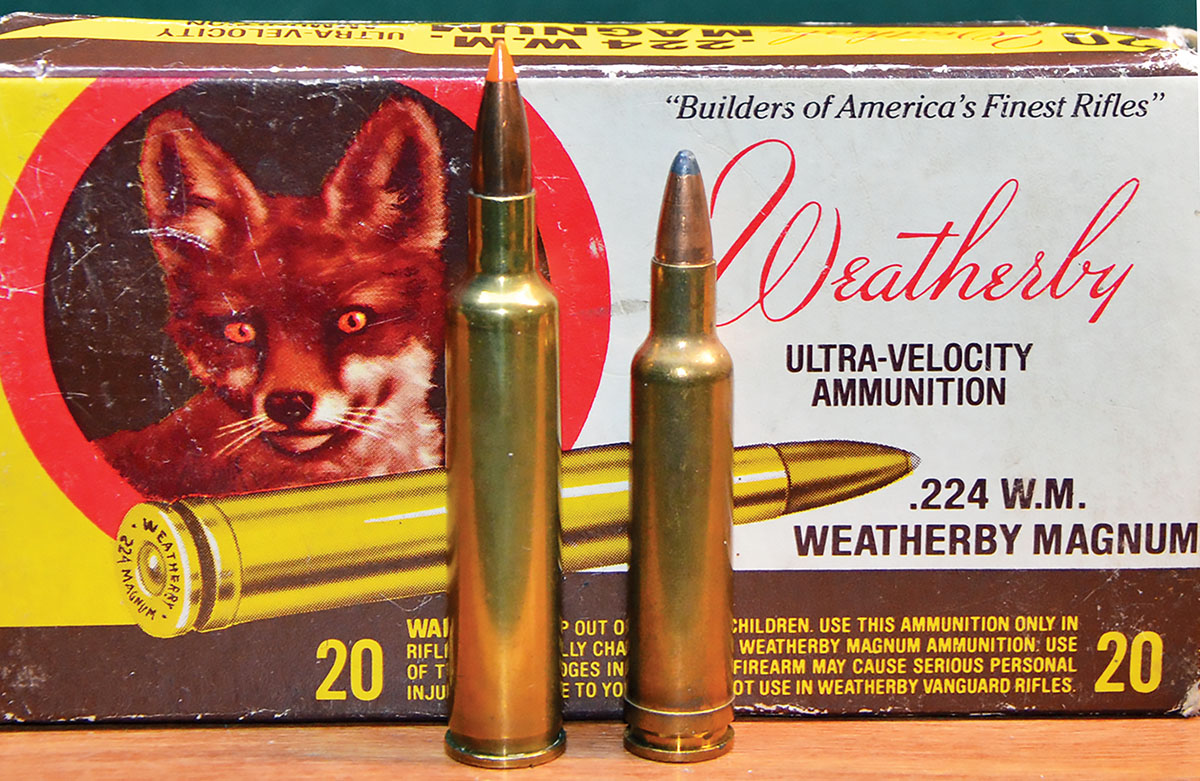
Roy Weatherby built rifles in 220 Rocket until he came up with the 224 Weatherby Magnum with a belted case and his familiar double-radius shoulder. He did not get around to offering the new cartridge until developing a drastically scaled-down version of his later Mark V action. Called the Weatherby Varmintmaster, it was introduced in 1963. Cartridges shown here are the 220 Rocket (left) and the 224 Magnum (right).
The first
Tomorrow’s Rifles Today catalog was published by Roy Weatherby in 1945 and it featured the cartridges he had developed up until that time. They were the 220 Rocket, 257 Magnum, 270 Magnum and 300 Magnum. In those days, Weatherby was building rifles around various actions including the Winchester Models 54 and 70, Remington Model 30, 1903 Springfield and 1898 Mauser. The barrels used had chromed bores and they were said to be made of a new steel called Graph-Mo developed by the Timken Roller Bearing Company. Barrel accuracy life was claimed to be considerably longer than barrels made of other types of steel. Weatherby eventually switched mostly to Mauser actions purchased directly from FN and they were heat-treated to his specifications. That arrangement ended in 1958 with the introduction of the Mark V action which is still in production today.
After abandoning experimental .22-caliber cartridges on the 257 Roberts, 30-06 and shortened 300 H&H cases, Weatherby settled on the 220 Swift case fire-formed to less body taper and given a 30-degree shoulder. Unlike his magnum cartridges of .257, .270 and .300 calibers, the 220 Rocket did not have Weatherby’s signature double-radius shoulder. Load data included in the 1945 catalog listed maximum velocities with a 55-grain bullet as 4,100 fps with IMR-4064 and 4,095 fps with IMR-4320. It was noted that Remington 220 Swift cases were used and maximum powder charges should be reduced by two grains if cases made by Winchester were substituted.
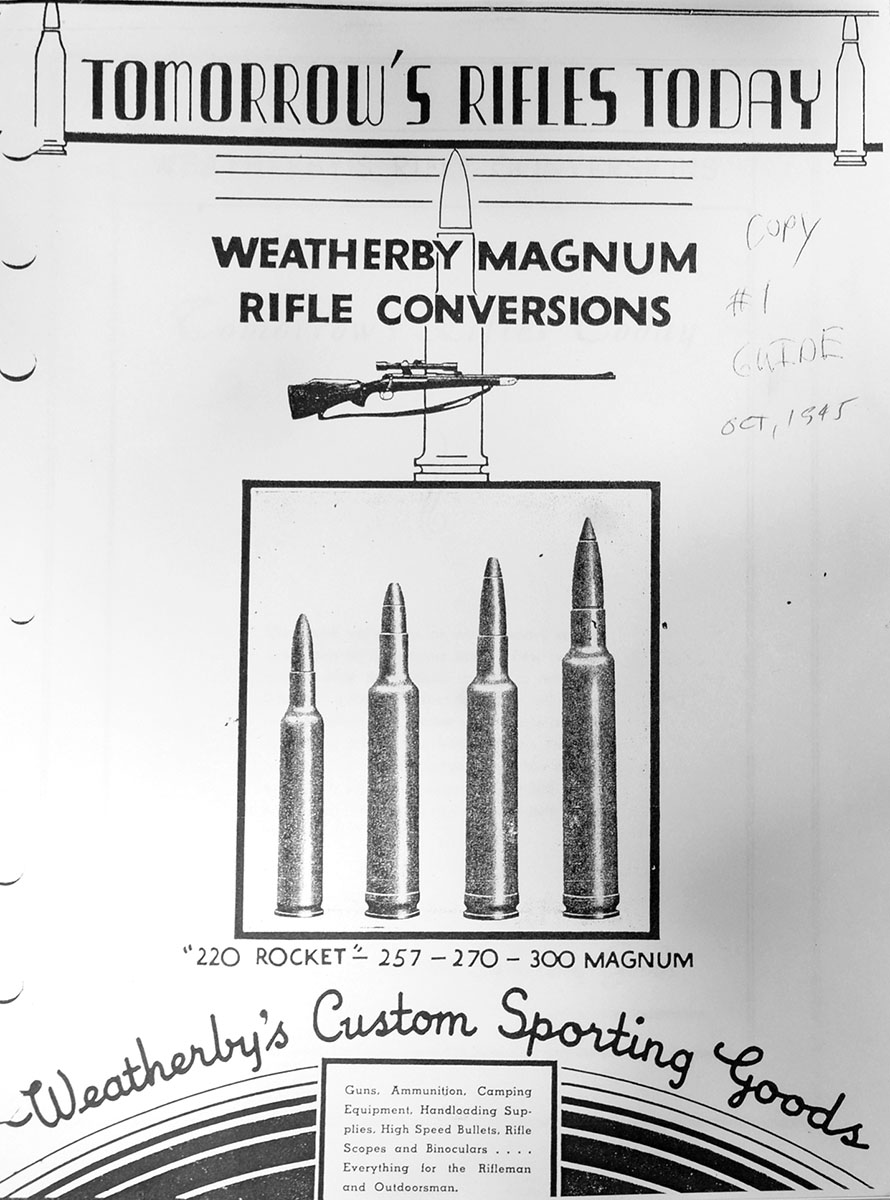
The cover of Roy Weatherby’s first catalog published in 1945 has the four cartridges developed by him up until that time: 220 Rocket, 257, 270 and 300 Magnum.
The Rocket also appeared in the 1947 Weatherby catalog and its cover had a heavy-barrel rifle chambered for it. On a FN Mauser action, the stock was of California Mesquite. The 228 Weatherby Magnum and 7mm Weatherby Magnum, both on the 270 Magnum case, had been added. The 228 Magnum used a .227-inch bullet weighing 70 grains with a maximum velocity of 3,800 fps and with the exception of its double-radius shoulder, the case was similar to the 230 Ackley Magnum. The 1953 Weatherby catalog is the latest on my shelf that has the 220 Rocket and while a 55-grain bullet at 4,100 fps was still listed in the data chart, it had been joined by a 60-grain bullet at 3,725 fps, compliments of a maximum charge of IMR-4350.
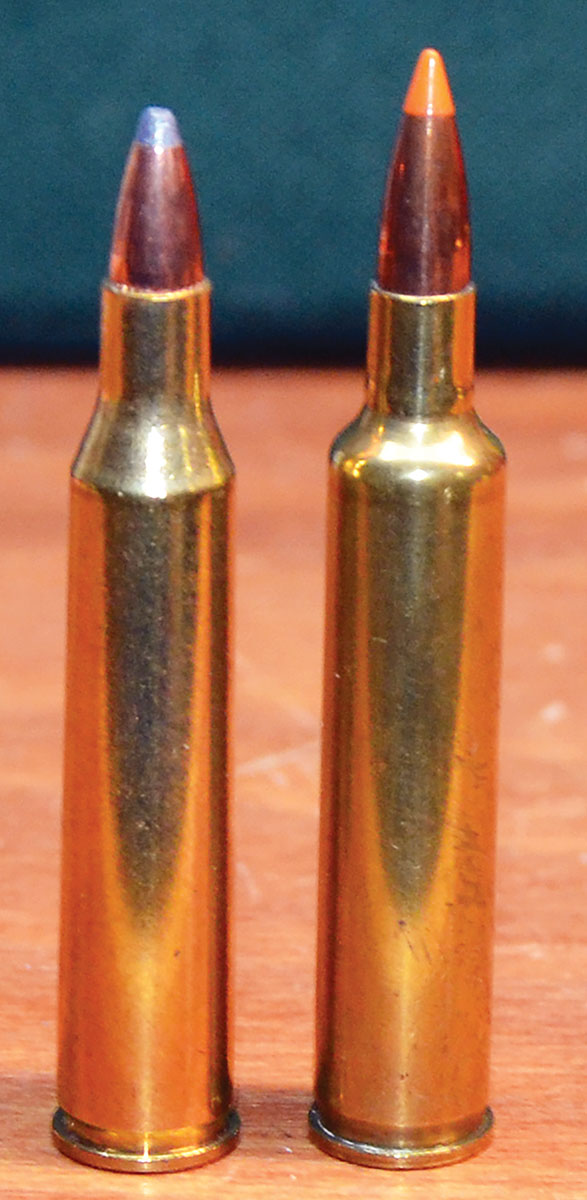
Fire-forming the 220 Swift case (left) in the chamber of a rifle in 220 Rocket increased its capacity by about 9 percent. Velocity gained varied with various powders used varied but since 3⁄4 inch of freebore in the chamber of the Weatherby rifle allowed the use of heavier powder charges, it was usually a bit faster than for the standard 220 Swift.
While the stock of my rifle represented the beginning of what would later be described by Jack O’Connor as “the California look,” its lines were a bit more conservative than would come later. “Tomorrow’s Rifle Today” in small lettering was molded into the rear surface of its Pachmayr recoil pad. Roy Weatherby and Maynard Buehler were good friends and the bolt shroud on the FN Mauser action of my rifle had been modified for a two-position safety lever designed and sold by Buehler. Engraving on the left side of the receiver ring read “Weatherby, South Gate. Calif.” Oddly enough, the Mauser extractor was not modified to slip over a chambered round and all cartridges had to be fed from the magazine. While the floor plate was not hinged, an extended release button made the magazine easy to unload. The rifle came with a Lyman Wolverine All Weather 10x scope with a 26mm tube held in place by a two-piece Buehler mount. Weighing only 12 ounces and measuring 14 inches long, its adjustments were precise and optical quality left nothing to be desired.
The amount of capacity gained by “improving” a rifle case is greatly dependent on the amount of taper in its case and it was about 9 percent for the 220 Rocket. More specifically, Hornady cases fire-formed in my rifle held 53.4 grains of water. Moving forward to more modern times, my batch of Peterson 22 Creedmoor cases hold 49.3 grains of water and my 22-250 Improved (Federal fire-formed case) holds 50.2 grains.
In a letter dated September 28, 1981, from Roy Weatherby, he had the following to say in response to my letter to him requesting any information he might wish to share on his 220 Rocket and my rifle chambered for it: “You are the first person to ask me about my 220 Rocket and 228 Magnum in many years. The 228 was on the shortened 300 H&H case and it was designed for shooting varmints at extremely long range with bullets heavier than those of .224 caliber. Loaded with a 70-grain bullet at 3,850 fps, it was also an excellent choice for use on deer and antelope, although I have letters from customers who have used it successfully on elk, moose and various African antelope. You mentioned having a copy of my 1947-1948 catalog. Note the photo on page 33 of penetrations tests we performed on 1⁄2-inch armor plate. At a distance of 100 yards, bullets fired from all of my cartridges, including the 228 Magnum and 220 Rocket completed penetrated it while it was defeated by the 300 H&H and others.”

This rifle is built on the FN Mauser action with Roy Weatherby’s racy-stock styling. It is exactly like the rifle in 220 Rocket once owned by Layne and eventually sold to a member the Weatherby Collectors Association.
“The 220 Rocket was actually the first cartridge I started fooling with before starting my business in 1942. When I finally got around to building custom rifles, it was one of the first four cartridges introduced. If memory serves me correctly, I chambered rifles for it until about 1951. In those days I had no way of measuring chamber pressure and velocities were from a home-built chronograph. Increasing the shoulder angle of the 220 Swift case to 30 degrees reduced stretching but to be quite honest, there was not enough velocity gain over the standard 220 Swift to warrant all the trouble of fire-forming cases. The smaller 224 Magnum with its belted case that I developed during the late 1940s was a better cartridge but I had to hold off introducing it until the funds became available for developing an action for it that was smaller than my Mark V action. That day arrived in 1963 with the introduction of the Weatherby Varmintmaster. Based on the serial number of your rifle, I’d say it was built in 1950. It would be of great interest to collectors of my rifles because I built very few in 220 Rocket of which less than 100 were on the FN Mauser action.”
D
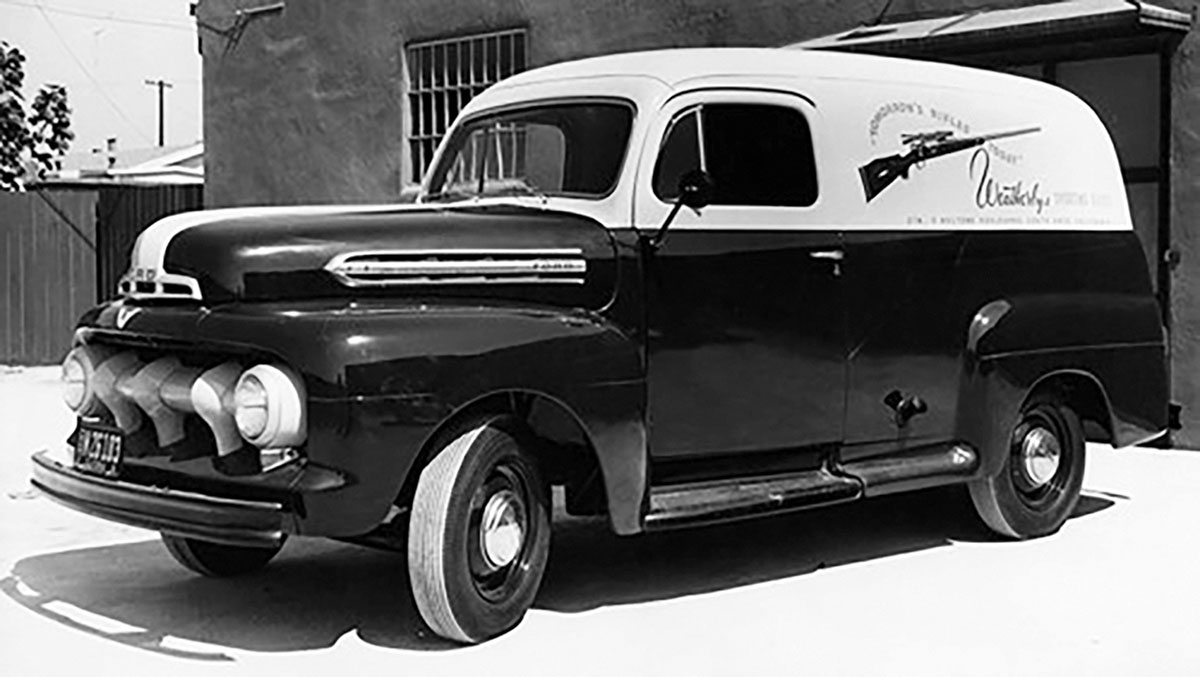
During the era when Layne’s rifle in 220 Rocket was built, Roy Weatherby often hit the road in this Ford panel truck and visited gun dealers across the country. A sliding drawer in a concealed compartment in the floor of the vehicle held a dozen of his rifles.
uring my life I have owned two rifles that had collectors salivating at my door. One was a mint-condition, high-grade Winchester Model 71 carbine with a 20-inch barrel in 348 Winchester. From the old Winchester custom shop, it had fancy wood with flawless checkering, a touch of conservative engraving here and there and a Winchester peep sight riding to and fro atop its bolt. The other desirable was the Weatherby rifle in 220 Rocket accompanied by its original Lyman Wolverine scope and a RCBS die set. The Model 71 went to a Winchester collector and since Phyllis and I were only recently married, that money bought much-needed furnishings for our small home. Just as Roy Weatherby had predicted some years prior, a member of the Weatherby Collectors Association desired the 220 Rocket much more than I.
A final note is in order. When selling my rifle, all formed cases went with it and my thanks to friend and colleague Stan Trzoniec for sending a couple of 220 Rocket cartridges for this report. As mentioned earlier, the 220 Rocket case had a 30-degree shoulder rather than Weatherby’s double-radius shoulder, but when having a custom rifle in 220 Rocket built a few years back, Stan decided to be different by ordering a chamber reamer with the double-radius shoulder. This is easily seen in my photos of the cartridge.
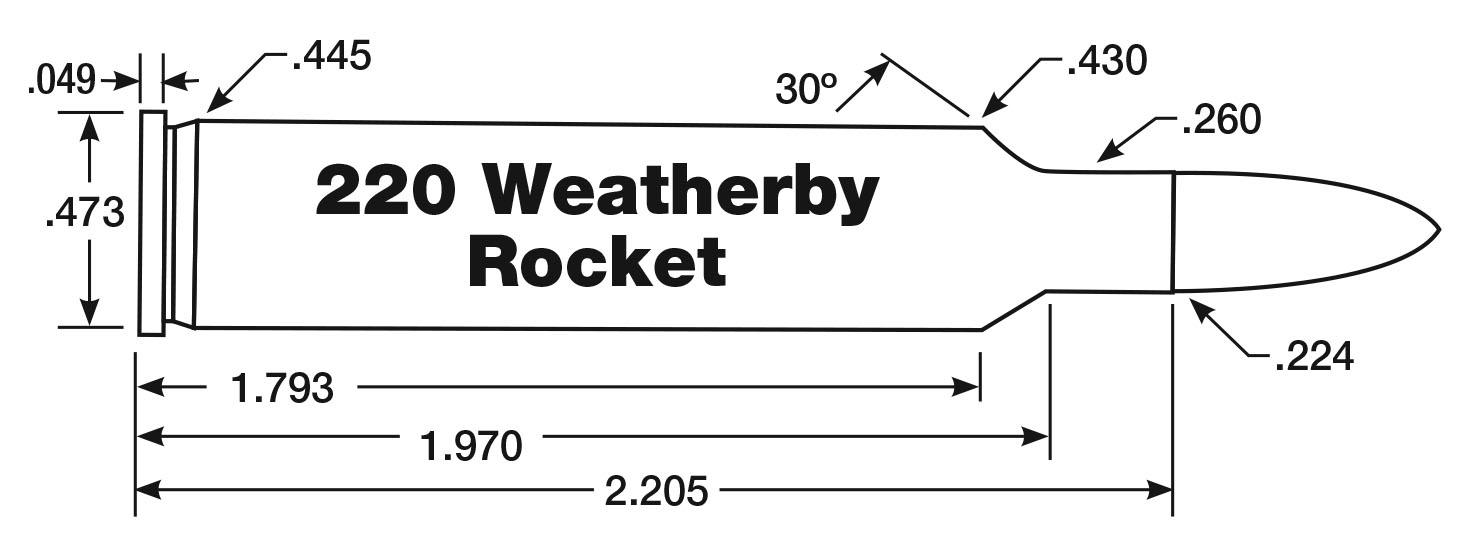





.jpg)


